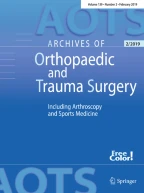Abstract
Introduction
The influence of transient circulatory arrest on oxidant status during the healing of a tibial fracture was investigated in rats by the use of a hindlimb tourniquet technique.
Materials and methods
One of the most reliable indicators for cytological damage is lipid peroxidation, which can be demonstrated by malondialdehyde (MDA) levels. Fifty-eight Wistar rats were used in this study. To determine the basal MDA levels of bone, 10 rats not exposed to ischemia were killed by an overdose of ether. The remaining 48 rats were randomly divided into two groups (control and ischemia). The control and ischemia groups were then randomly divided into 4 groups of 6 rats each. In 48 rats, the left tibia was fractured and fixed intramedullarly. In the ischemic group, complete acute transient ischemia for 4.5 h was imposed after the fracture. In the control group, no other intervention except the fracture was done. Rats from the control and ischemic groups were killed on days 3, 7, 14, and 28, and MDA levels were determined in tibial bone and callus tissue. The MDA levels of the control and ischemic groups were compared with basal MDA levels in the bone of 10 rats.
Results
There was an apparent difference between the basal and control group MDA levels on days 3 and 7 (p<0.01), between the basal and ischemic group MDA levels on days 3, 7, and 14 (p<0.01). In addition, the ischemic group showed a statistically significant increase in MDA levels on days 3, 7 and 14 compared with the control group (p<0.01).
Conclusion
We conclude that complete acute transient ischemia affects the oxidant status during fracture healing. This effect especially occurs during the ischemic period, inflammation, and callus formation of fracture healing.
Similar content being viewed by others
References
Blaisdell FW (2002) The pathophysiology of skeletal muscle ischemia and the reperfusion syndrome: a review. Cardiovasc Surg 10:620–630
Bulkley GB (1983) The role of oxygen free radicals in human disease processes. Surgery 94:407–411
Cornell CN, Lane JM (1992) Newest factors in fracture healing. Clin Orthop 277:297–311
Freeman BA, Crapo JD (1982) Biology of disease: free radicals and tissue injury. Lab Invest 47:412–426
Göktürk E, Turgut A, Baycu C, Günal İ, Seber S, Gülbas Z (1995) Oxygen free radicals impair fracture healing in rats. Acta Orthop Scand 66:473–475
Halliwel B, Gulteridge JMC (1984) Lipid peroxidation, oxygen radicals, cell damage and antioxidant therapy. Lancet i:1396–1398
Kase T, Skjeldal S, Nordsletten L, Reikeras O (1998) Healing of tibial fractures is not impaired after acute hindlimb ischemia in rats. Arch Orthop Trauma Surg 117:273–276
Lowry OH, Rosebrough NJ, Farr A, Randall R (1951) Protein measurement with the folin phenol reagent. J Biol Chem 193:265–275
McCord JM (1985) Oxygen derived free radicals in postischemic tissue injury. N Engl J Med 312:159–163
Nohl H (1993) Involvement of free radicals in ageing: a consequence or cause of senescence. Br Med Bull 49:653–667
Nordsletten L, Madsen JE, Almaas R, Rootwelt T, Halse J, Kontinen YT, Hukkanen M, Santavirta S (1994) The neuronal regulation of fracture healing-effects of sciatic nerve resection in rat tibia. Acta Orthop Scand 65:299–304
Nylander G, Otamiri T, Lewis DH, Larsson J (1989) Lipid peroxidation in postischemic skeletal muscle and after treatment with hyperbaric oxygen. Scand J Plast Reconstr Surg Hand Surg 23:97–103
Oda T, Nakai I, Mitou M, Yamagisi H, Oka T, Yoshikawa T (1992) Role of oxygen radicals and synergistic effect of superoxide dismutase and catalase on ischemia-reperfusion injury of the rat pancreas. Transplant Proc 24:797–798
Ohkawa H, Ohishi N, Yagi K (1979) Assay for lipid peroxides in animal tissues by thiobarbituric acid reaction. Anal Biochem 95:351–358
Petrovich YA, Podorozhnaya RP, Kichenko SM, Kozlova MV (2004) Effects of selenium-containing compounds and their metabolism in intact rats and in animals with bone fractures. Bull Exp Biol Med 137:74–77
Prasad G, Dhillon MS, Khullar M, Nagi ON (2003) Evaluation of oxidative stress after fractures. A preliminary study. Acta Orthop Belg 69:546–551
Rangan U, Bulkley GB (1993) Prospects for treatment of free radical mediated tissue injury. Br Med Bull 49:700–718
Schmidley JW (1990) Free radicals in central nervous system ischemia. Stroke 21:1086–1090
Seyama A (1993) The role of oxygen derived free radicals and the effect of free radical scavengers on skeletal muscle ischemia/reperfusion injury. Surg Today 23:1060–1067
Simmons DJ (1985) Fracture healing perspectives. Clin Orthop 200:100–113
Skjeldal S, Grogaard B, Reikeras O, Müler C, Torvik A, Svindland A (1991) Model for skeletal muscle ischemia in rat hindlimb evaluation of reperfusion and necrosis. Eur Surg Res 23:355–365
Skjeldal S, Svindland A, Hvaal K, Kase T, Reikeras O, Nordsletten L (1997) Severe hindlimb ischemia causes periosteal proliferation in the rat tibia. Acta Orthop Scand 68:593–597
Sugino K, Dohi K, Yamada K, Kawasaki T (1987) The role of lipid peroxidation in endotoxin induced hepatic damage and the protective effect of antioxidants. Surgery 101:746–752
Svindland AD, Nordsletten L, Reikeras O, Skjeldal S (1995) Periosteal response to transient ischemia: histological studies on the rat tibia. Acta Orthop Scand 66:468–472
Turgut A, Göktürk E, Köse N, Kaçmaz M, Öztürk HS, Seber S, Acar S (1999) Oxidant status increased during fracture healing in rats. Acta Orthop Scand 70:487–490
Turk C, Halici M, Guney A, Akgun H, Sahin V, Muhtaroglu S (2004) Promotion of fracture healing by vitamin E in rats. J Int Med Res 32:507–512
Weiss AP, Carey LA, Randolph MA, Moore JR, Weiland AJ (1989) Oxygen radical scavangers improve vascular patency and bone muscle cell survival in an ischemic extremity replant model. Plast Reconstr Surg 84:117–123
Yeler H, Tahtabas F, Candan F (2005) Investigation of oxidative stress during fracture healing in the rats. Cell Biochem Funct 23:137–139
Author information
Authors and Affiliations
Corresponding author
Rights and permissions
About this article
Cite this article
Cetinus, E., Kılınç, M., Uzel, M. et al. Does long-term ischemia affect the oxidant status during fracture healing?. Arch Orthop Trauma Surg 125, 376–380 (2005). https://doi.org/10.1007/s00402-005-0825-3
Received:
Published:
Issue Date:
DOI: https://doi.org/10.1007/s00402-005-0825-3
